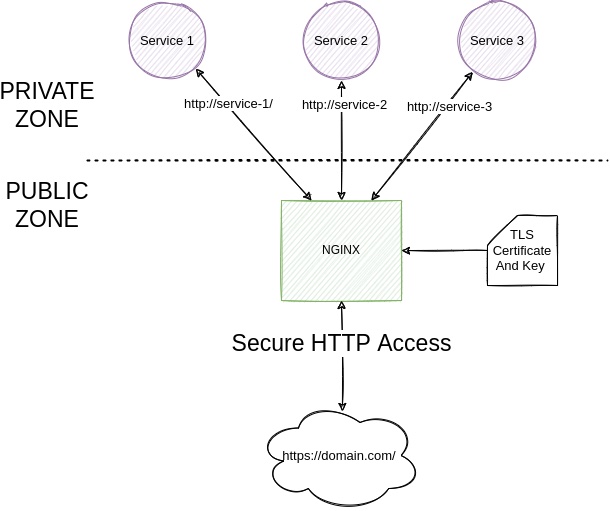ReductStore behind NGINX
I think, NGINX doesn't need any introductions. It is one of the most widely used HTTP servers and reverse proxies. You can route your microservices or monolith application through it and make it responsible for:
- TSL encryption
- Basic HTTP authorization
- Map public URL to services or applications
- Load balancing
This is a typical use case for NGINX:

Although, ReductStore supports TSL encryption and token authentication, there are a few cases where NGINX could be useful:
- Integration of the database into an existing infrastructure;
- Usage of CertBot or other tools to obtain TSL certificates automatically;
- Several instances of ReductStore on one node;
The last case might be especially useful because ReductStore is an asynchronous single-threaded application. This makes the storage engine very robust and efficient, but to scale it, you have to spin up new instances.
In this tutorial I'll show you how you can launch two ReductStore instances by using Docker Compose and split them by using subpaths in NGINX.
Docker Compose Configuration
First, we have to prepare our docker-compose.yml file:
version: "3"
services:
storage-1:
image: reduct/store:latest
environment:
RS_API_BASE_PATH: "storage-1/" # API available on http://storage-1/storage-1
volumes:
- ./storage-1:/data # separated volume for data
storage-2:
image: reduct/store:latest
environment:
RS_API_BASE_PATH: "storage-2/"
volumes:
- ./storage-2:/data
nginx:
image: nginx:alpine
volumes:
- ./nginx/nginx.conf:/etc/nginx/nginx.conf # pass customised configuration to NGINX
depends_on:
- storage-1
- storage-2
ports:
- "80:80" # public port
Here you can see two completely independent databases. They use different volumes and have different API paths.
By default, the HTTP API and Web Console is accessible at http(s)://hostname:port/, but we can change it by using the
variable
RS_API_BASE_PATH. Actually, we could use NGINX to map paths storage-1 and storage-2 to different instances and
keep
the default API paths, but then web console would stop working.
Also, you should pay attention that we don't publish ports of the engines. The only public port is 80 which is used by NGINX, we keep our engines in a private zone and access them through the reverse proxy.
NGINX Configuration
Now we need to setup NGINX. For this, we create our own nginx.conf file and mount it to the container as a volume.
You can find the full configuration here.
Here are our changes:
http {
/* default configuration */
upstream storage-1 {
server storage-1:8383;
}
upstream storage-2 {
server storage-2:8383;
}
server {
listen 80;
server_name nginx;
location /storage-1/ {
proxy_pass http://storage-1/storage-1/;
proxy_http_version 1.1;
proxy_set_header Host $host;
}
location /storage-2/ {
proxy_pass http://storage-2/storage-2/;
proxy_http_version 1.1;
proxy_set_header Host $host;
}
}
The idea is very simple. We specify our storage engines as upstream servers storage-1 and storage-2. Then
we map paths /storage-1/ and /storage-2/ to the upstream servers by using the location directive.
If you run everything together with docker-compose up you can find the both engines available
on http://127.0.0.1/storage-1/
and http://127.0.0.1/storage-2/
Conclusions
Because ReductStore has HTTP API to access its data, you can easily use it with other technologies like NGINX, Apache, K8S etc., and integrate it into your infrastructure. I hope this tutorial was helpful.
